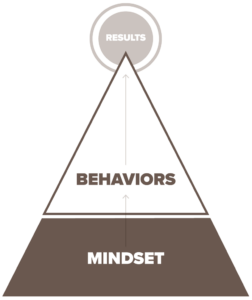A New Mindset for Better Relationships
Dear Springboard:
I like to think I’m very reasonable. I have a co-worker who has to one-up me every time I speak in our staff meetings. No matter what I say, he has to say something right after just to make himself look good.
I’ve tried to give him a hint. I’ve added my own comments to his contributions a few times and he didn’t get the message. He keeps doing it.
Sign me,
Fed Up
Dear Fed Up,
What you write about makes me think of what the Arbinger Institute calls collusion.
I attended one of their two-day workshops just last week.
They believe that mindset is the place to start in addressing problems. Sometimes people will emulate another’s behavior to try to get similar results and it doesn’t work because the two people have very different mindsets.
They point out that it is mindset that drives behavior.

Problems begin when someone crosses their own value system.
Here’s an illustration from the Arbinger Institute’s book Leadership and Self-Deception: Tom wakes at 1 AM Thursday and hears his infant daughter Debbie crying.
He knows his wife Nancy is tired and feels the right thing to do is get up and feed Debbie.
Instead, he pretends to be asleep, hoping Nancy will hear the cries and handle it.
By pretending to be asleep and avoiding what he knows is right, Tom has self-betrayed himself.
So, this leads to justifying his choice. He thinks to himself: I’m sensitive. I’m a good dad and good husband. I’ve been working hard and I deserve a break.
And for his wife: She can manage this one. After all, she’s not working anymore. She’s home all day and what is she doing with all that time anyway? Come to think of it, she’s kind of lazy. I’m the one who’s slugging it out.
In Arbinger’s language, Tom is now “in the box.” He has an inward mindset focused on his needs; and knowing he has made a choice that isn’t right, he must justify it.
When someone is “in the box,” they don’t see the other as a person but as an object — an object as a vehicle to serve our needs, an obstacle in our way, or just irrelevant.
What’s the effect of this? It drives a wedge in their relationship.
And, what is Nancy’s response?
She knows Tom is awake and he’s faking. So, she thinks: I’m home all day with the baby and not getting any breaks. I’m exhausted. The least my no-good husband could do is take a turn feeding the baby. What a jerk! And what’s more, he’s deliberately doing this to me.
So, now Nancy is in her box.
Each of them feels victimized by the other and so they are in collusion. The circle will continue.
In fact, both Tom and Nancy are motivated to continue to see the other as a jerk so they can continue to feel justified in blaming the other for being a jerk. Round and round it goes.
Plus, Tom’s blaming invites the very behavior he is blaming Nancy for. And so it is with Nancy, also.
While either Tom or Nancy could complain – with some legitimacy – about the other, it’s not the whole story. Their participation is perpetuating a cycle. They have a choice to shift their mindset.
As it says in the book, “The box is a metaphor for how I’m resisting others. By ‘resisting,’ I mean my self betrayal isn’t passive. In the box, I’m actively resisting what the humanity of others calls me to do for them.”
So, does this mean we should all feel obligated to take care of everyone we encounter – to always put other’s need ahead of our own?
No, it’s not about being a doormat.
It is about recognizing others and their human needs and being honest with ourselves about how we can be appropriately respectful, and interestingly, in so doing so, how we build trust.
How to get out of the box?
Not by focusing on ourselves. When we’re in the box, our thinking goes to rationalizing and self-deception.
The answer is to stop resisting the humanity of the people around us, to accept people as humans and not objects.
Freedom comes when we stop resisting what is outside the box – other people.
Interesting that the solution is to surrender.
From the Watercooler
springboard

